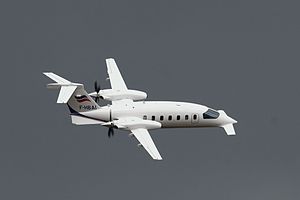Piaggio Avanti
| P.180 Avanti | |
|---|---|
 |
|
| Role | Executive transport |
| National origin | Italy |
| Manufacturer | Piaggio Aero |
| First flight | 23 September 1986 |
| Introduction | 30 September 1990 |
| Status | In production |
| Primary users |
Italian Air Force Italian Army Italian Navy |
| Produced | 1986–present |
| Number built | 216 delivered as of November 2011 |
| Unit cost |
US$7.395 million (2016)
|
The Piaggio P.180 Avanti is an Italian executive transport aircraft with twin-turboprop engines mounted in pusher configuration. It seats up to nine passengers in a pressurized cabin, and may be flown by one or two pilots. The design is of three-surface configuration, having both a small forward wing and a conventional tailplane as well as its main wing, with the wing spars passing outside of the passenger cabin area.
Design studies began in 1979 and designs were tested in wind tunnels in Italy and the United States in 1980 and 1981. A collaboration with Learjet to develop the aircraft began in 1983, but ended on 13 January 1986, with Piaggio continuing development on its own. The first prototype flew on 23 September 1986. American and Italian certification was obtained on 2 October 1990. Learjet's influence can be seen in the two "delta fins" mounted on the bottom of the tail, as found on most Learjets; these devices help provide yaw stability and pitch stability at high angles of attack.
The first 12 fuselages were manufactured in Wichita, Kansas, with H & H Parts and Plessey Midwest, then flown to Italy for final assembly. Avanti Aviation Wichita ran out of money in 1994; the project languished until a group of investors led by Piero Ferrari became involved in 1998. The 100th aircraft was delivered in October 2005 and the 150th in May 2008. Piaggio has reported that, as of October 2010, the Avanti and Avanti II fleets have now logged over 500,000 flying hours.
An improved Avanti II obtained European and U.S. certification in November 2005. Six months later, 70 planes had been ordered, including 36 by Avantair. The Avanti II features uprated Pratt & Whitney Canada PT6 turboprop engines and flies about 18 km/h (11 mph) faster, with better fuel economy; an all-new "glass panel" avionics suite reduces cockpit clutter. In addition to heading, attitude and navigation information, flat panel color LCD displays add collision avoidance (TCAS), ground proximity (TAWS) and real-time graphic weather depiction.
...
Wikipedia
